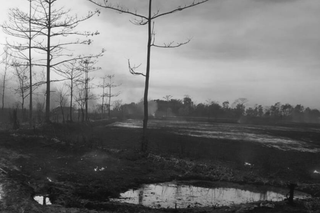
The Assam Oil Fire Is Doused — But Its Damage Is Ongoing
“The toxins released [by the fire] are known to have long-term persistence in soils and sediments.”

The Baghjan oil spill fire in Assam is doused now, after burning for more than five months and requiring coordinated efforts from experts in India, the U.S., Singapore, and Canada.
But the fire’s proximity to the Dibru Saikhowa National Park and the Maguri-Motapung Beel wetlands, and its forced evacuation of more than 2,500 people, mean the harm to both biodiversity and livelihoods will linger, experts have warned.
“The toxins released [due to the oil and gas spill] are known to have long-term persistence in soils and sediments, which will not only affect current life conditions but, due to sustained release over a long period, pose a serious health risk for a longer term,” according to a report from July by the Wildlife Institute of India (WII), an autonomous body under India’s Ministry of Environment, Forest and Climate Change. Some of these pollutants will leach into the ground and contaminate groundwater as well, the statement added.
In June, while the fire still raged, droplets of condensate, or residue from gas condensing after coming into contact with water from dousing efforts, pread across a radius of 5 kilometers and settled on tea gardens, grasslands, and water bodies nearby. Reportedly, the droplets contain highly toxic and carcinogenic chemical compounds.Experts state that the blowout can also lead to oils lingering underground for centuries, causing hydrocarbon poisoning to animals through the soil. “The incident has caused damage that would require years to repair or heal. There are several crucial biodiversity zones, which are at distances of about three kilometers from the site of the fire,” a government official from Assam told BBC.
Related on The Swaddle:
Forest Fires Are Raging Dangerously Close To Chernobyl’s Nuclear Site
The WII also noted spikes in nitrogen dioxide, sulfur dioxide, and formaldehyde into the environment in the air since the fire broke out, alongside a decline in dissolved oxygen levels in surrounding water bodies — leading to a decrease in fish diversity and abundance.
Many people have also been displaced and are awaiting compensation. “Even if the fire is doused, we cannot possibly go and live in that house anymore — we lost not just our cows, goats, fields, crops but our mental and physical peace, too,” farmer Akhileshwar Chetia, who has been living in a relief camp since the fire broke out 50 meters from his house and burnt his properties, told The Indian Express this week.
In addition to displacement, the livelihoods of locals have also been harmed. “Agriculture, fishing, and animal rearing are the main occupation of most people in this area. But now because of the oil spill, agricultural land will become infertile and no farming will be possible for many years. Also, fishes and domestic animals are dying in large numbers because oil has contaminated grasslands and water bodies,” Niranta Gohain, an environmental activist from the region, told The Wire.
Moreover, the oil blowout also poses a threat to the health of locals. Research suggests that prolonged exposure to toxic constituents of natural gas can also lead to long-term cardiovascular, respiratory, and neurological effects in humans. The health damage has begun already. “People in the area have reported severe breathing difficulty, headaches, and nausea … even our survey team has suffered from the same symptoms and experienced heavy presence of oil and chemicals in the environment,” WII had reported.
Related on The Swaddle:
An Amazon Forest Fire Is Now Large Enough To Be Seen from Space
However, the state-owned Oil India Limited (OIL), which owns the oil-well where the fire broke out, has continued to deny there will be any long-term impact from its spill. “Because of the nature of the gas and the condensate, they easily evaporate and are washed away by rains. These elements do not have long-term impact either on the air or the soil,” Tridiv Hazarika, a senior public relations manager of OIL, told the media.
In the meantime, an expert panel of the National Green Tribunal, a specialized body created by the government for effective and expeditious disposal of cases pertaining to environmental issues, has fixed compensations of Rs. 25 lakhs to families severely affected by the fire, and Rs. 20 lakhs to families less affected. But money can’t fix everything.
“Some trees and grasslands might look okay today and they might have withstood the initial shock but we do not know what kind of physiological impacts have occurred,” Narayan Sharma, part of an expert committee set up by the Assam state government to assess the disaster, told Scroll.in.
Devrupa Rakshit is an Associate Editor at The Swaddle. She is a lawyer by education, a poet by accident, a painter by shaukh, and autistic by birth. You can find her on Instagram @devruparakshit.
Related


New Primate Species Discovered In Myanmar Already Facing Extinction
